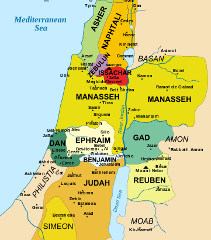An Atheist Evolutionist Asks a Good Question of Dr. Peter Enns
Body
“For a long time now BioLogos has ignored its initial mission of trying to convert evangelical Christians to evolution. It didn’t work—as I predicted—because those Christians know that if you buy Darwinian evolution, then you have to see much of the Bible as either fictional or at best metaphorical.
Discussion
The Ten Tribes of Israel: Were They Lost?

Read Part 1.
A detailed refutation of the various explanations of Israel’s northern tribes is impossible within this format. The great Hebrew Christian scholar, David Baron, in his work The History of the Ten “Lost” Tribes has provided the most detailed and accurate answer to the question. The following is a summary of his main points with a few personal observations. The fallacy inherent in all of the theories is simply this: the tribes were never lost, but continued as part of the main body of the Jewish people. Consider the following five points:
1. At the time of the disruption of the united kingdom in 930 B.C., faithful Israelites from all the northern tribes joined their brethren in the south and continued their identity as part of the kingdom of Judah. Two books in Scripture that are strangely ignored by British-Israelites are 1 and 2 Chronicles. These books make it clear that the tribes in the north continued their existence as part of Judah after 930 B.C. Consider 2 Chr 11:14, 16: “For the Levites left their suburban lands and their possession, and came to Judah and Jerusalem; for Jeroboam and his sons had cast them off from executing the priest’s office unto the LORD; …. And after them, out of all the tribes of Israel, such as set their hearts to seek the LORD God of Israel came to Jerusalem, to sacrifice unto the LORD God of their fathers.” These verses provide irrefutable proof that many godly individuals out of “all the tribes of Israel” rejected Jereboam’s idolatry and joined the southern kingdom. During the reign of Asa, others followed from Ephraim and Manasseh (2 Chr. 15:9). Thus, it is evident that the kingdom of Judah absorbed many from the northern kingdom through the years.
Discussion
Reason's Relationship to Revelation
What is reason’s relationship to Revelation? My understanding is that we do not subject the Bible to reason. We believe that things that are truly reasonable will be in complete agreement with the Bible. Therefore, we judge our observations by the Scriptures, and, if necessary, reconcile our observations to the Scriptures. We do this on the basis that the Holy Bible is the very Word of God, and thus, infallible.
Discussion
Book Review - Come, Let Us Reason
Since the first century, the church has been involved in one way or another in the ministry of apologetics. Within the last few decades, as atheists have seemed to ramp up their religious efforts to discredit and eradicate the belief in God and Christianity more specifically, Christians have ramped up their apologetical focus with matching intensity.
Discussion
The Ten Tribes of Israel: Lost or Found?

In December, 1984, astounding news leaked to the world press. For over a year, the Israeli government had been secretly flying over ten thousand Ethiopian Jews out of their refugee camps in the Sudan to their new homes in the modern state of Israel. The Beta Israel, as they call themselves (Falashas in the Ethiopian language), claim that their Judaic faith originated after the Queen of Sheba returned from her famous visit to King Solomon, bringing with her the knowledge of the one true God. Rabbis in Israel, however, had another explanation—these Ethiopian Jews were descendants of the tribe of Dan, one of the mysterious lost tribes of Israel.
Occasionally an article will describe the Jewish customs of the Pashtu—an Islamic tribe in Afghanistan. They circumcise their sons on the eighth day, wear four-cornered garments, perform levirate marriages and wear traditional sidelocks and beards. These customs have convinced some researchers that the Pashtu tribe is a remnant of the ten lost tribes of Israel.
A prominent American radio and TV “evangelist” proclaimed for years that the ten lost tribes were not lost but had reappeared as the British and American peoples, whom, he claimed, were the inheritors of the promises to ancient Israel! These various ideas appearing in the twentieth century have again raised some important questions in the minds of many: what did happen to the ten tribes? Have some of them survived until today? Can we identify these tribes with any of the many ethnic groups living on planet Earth today? This post attempts to answer these and other questions by sifting through the myths and ideas of men to ascertain the scriptural and historical truth about the so-called lost tribes.
Discussion
Reflections on Republocrat: The Secularization of America

This post continues my chapter-by-chapter review of Republocrat, by Carl Trueman (Part 1, Part 2). The chapter in focus here is the second, entitled The Slipperiness of Secularization. It’s thesis is that the US may seem to be less secularized than Britain, but probably isn’t. The reason is that here in the US, the church itself has become secularized in many ways. Hence, even though church attendance and religious language are far more common here than in the UK, these do not reflect genuine Christian faith and practice. To put it another way, Britain only seems more secular because it is more authentic about its unbelief rather than dressing it up like we do here.
After brief introductory paragraphs, Trueman develops the chapter under these headings:
- America: The Exception? (p. 22)
- British Christianity: The Dying of the Light (p. 23-25)
- The USA: Secularization, Religious-Style (p. 25-28)
- Secularization: Subtle and Speciously Orthodox (p. 28-32)
- The Patriot’s Bible and Beyond (p. 32-36)
- The Celebrity Syndrome (p. 37-39)
- Conclusion (p. 39)
Discussion
The Vanity of “Hoping to Goodness”
 Reprinted with permission from As I See It, which is available free by writing to the editor at [email protected]
Reprinted with permission from As I See It, which is available free by writing to the editor at [email protected]
Recently, we purchased several dozen books from a used bookstore, and were given a “freebie” book as part of the transaction. That book, The Five People You Meet in Heaven, published in 2003, was by Mitch Albom, whose earlier volume Tuesdays with Morrie, we read and reviewed in As I See It 4:3. Since that earlier work was well-written, and not without some merits, and this present volume was less than 200 pages, we decided to give it a read.
Unlike the former book, which was a factual account of the physical wasting away and death of one of Albom’s college professors, this current one, though also focusing on the issue of death, but especially the afterlife, was an entirely fictitious account. The story focuses on the death of an ordinary man, one Eddie, whose life outwardly amounted to little more than being a maintenance man at a small amusement park, a life unfulfilling and frustratingly wasted doing the menial. As the story goes, after death, this man goes through a series of encounters with five different people whose lives had deeply impacted his or whose lives had been deeply impacted by him. These encounters allow him to sort through his own frustrations especially with life-altering circumstances he didn’t cause and couldn’t control, and the unanswered “whys” of his life, so that he can be at peace with himself—this process and outcome being the very purpose of the afterlife. “And they lived happily ever after.”
All nice and neat except….
The book is written from a faulty perspective. In the dedication, the author mentions an uncle,
who gave me my first concept of heaven. Every year, around the Thanksgiving table, he spoke of a night in the hospital when he awoke to see the souls of his departed loved ones sitting on the edge of the bed waiting for him. I never forgot that story.
A rather subjective premise. But it gets worse.
Discussion
How do you understand the account of the Rich Man and Lazarus in Luke 16:19-31? Its relationship to Hades?
Poll Results
How do you understand the account of the Rich Man and Lazarus in Luke 16:19-31? Its relationship to Hades?

Discussion